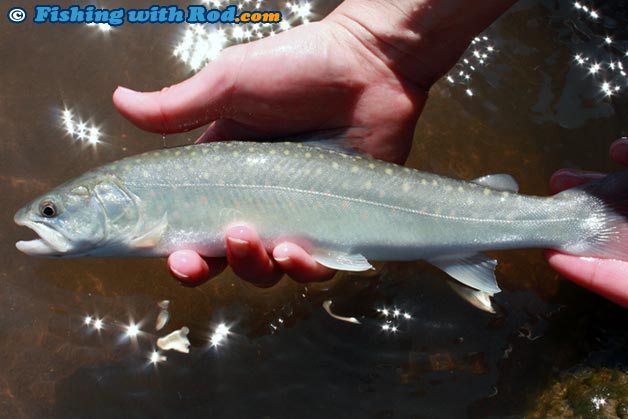Dolly Varden and Bull Trout, Which is Which?
By Rodney Hsu, Fishing with Rod | Published in June 2001

Often bar fishing in the Fraser River for salmon, you will often hear people complain, "Ah, not another dollie nibbling on my roe!" Other occasions, any anglers will be thrilled when hooking one of these 10lb so-called dollies. Just exactly what are dollies? Are they related to salmon, because they look just like salmon? Do they live like a salmon? The answers are yes and no. The so-called "dollies" are actually two different species - dolly varden and bull trout. Both look so alike that anglers often refer them as dollies. They are relatives of salmon, but they are more commonly known as "chars". Chars, trout and salmon make up one large "salmonid" group and they are characterized by their adipose fin. Chars differ to the rest by their conspicuous white thumbprint spots along the backside.
In Southern British Columbia, these predatory fish patrol the Fraser River and its tributaries year round, hunting for small fish and fish eggs. Their migratory pattern is irregular, depending on the distribution and abundance of food. Another word, they'll be in waters where the food is. They are also often found in the inshore waters, such as Burrard Inlet and Howe Sound. This type of migratory pattern is known as amphidromous, an unique lifestyle that is only found in several species since it is extremely difficult to adapt between the saltwater and freshwater environment.
As mentioned earlier, bull trout and dolly varden are extremely hard to differentiate. There are only two or three slight differences in their physical appearance that can be used to tell the two apart. Below is a table that summarizes these differences.
| Dolly varden | Bull trout | |
|---|---|---|
| Scientific name | Salvelinus malma malma | Salvelinus confluentus |
| Upper jaw length | Short, usually does not pass the eyes. | Longer, usually pass the eyes. |
| Anal fin ray number | 10 to 15 | Much more |
Although the dolly varden and bull trout look so alike, they are not as closely related as many people assume. In fact, they did not evolved from a common ancestor. The dolly varden is more closely related to the arctic char in the North, and the bull trout is more closely related to the whitespotted char in Asia. When the two populations met in the pacific northwest, they have manage to coexist ever since.
The two species have not been studied extensively. However in recent decades, Dr Eric Taylor at the University of British Columbia has used molecular biology as an effective tool to identify the two species. By identifying their genes, they are able to make accurate differentiation between the two species. In his recent co-published studies, he has found that the two species do interbreed and produce fertile hybrids. This makes visual identification even harder because of the intermediate characteristics.
So, finally the mysteries are solved, now you will be able to distinguish between a bully and a dolly when you hook one of these magnificent fish in the Fraser River or Pitt River. Remember, these chars are slow growing fish, some large fish are up to ten years of age. All of them need to be released in the Southern BC. Please handle with care when releasing them.

